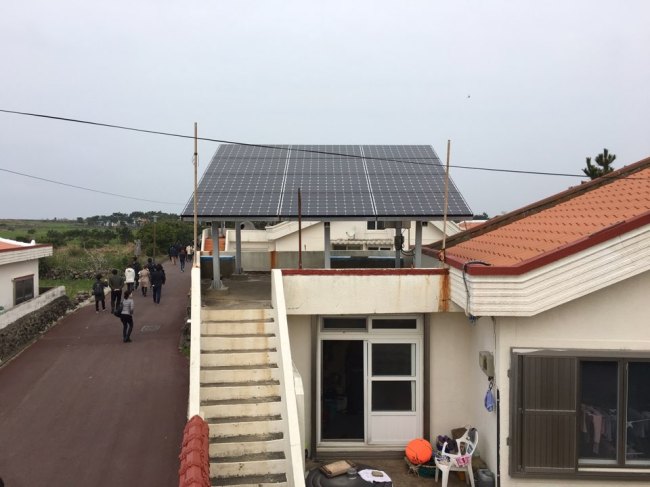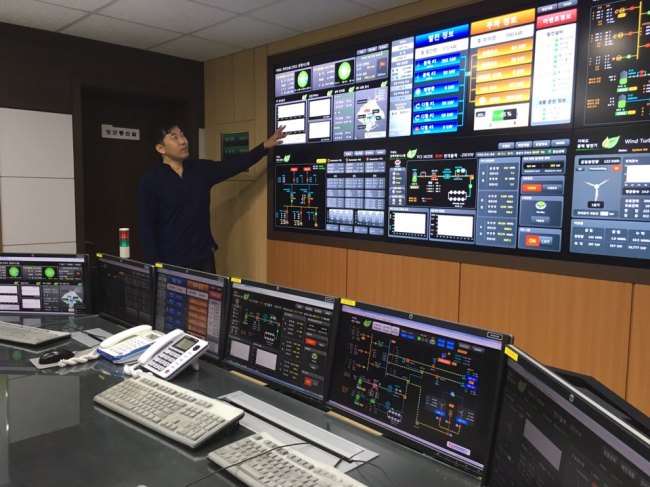 |
| Gapado Island’s wind generators overlook green barley fields on Saturday. (Kim Da-sol/The Korea Herald) |
GAPADO ISLAND, Jeju Special Self-Governing Province — Bundled up in padded coats and scarves, a group of visitors braved the cold, their hair flapping in the wind as they disembarked the ferry to Gapado Island.
The name Gapado comes from the meaning “island of wind and waves,” and the island’s village head, 61-year-old Kim Dong-ok says there is a reason for that.
“There’s an old saying that goes ‘wind (here) is strong enough to bend a cow’s horn,’” he said, greeting the group of journalists last Saturday.
But the wind might also be bending the fortunes of this island, which has seen its population dwindling in recent years, in the form of green energy.
Korea’s second-most southern island, Gapado is just a 15-minute ferry ride from Moseulpo port on Jejudo Island.
As of last year, a little more than 240 residents lived here. Over the last two decades, the number went down by 800.
“To fight the declining population here, we came up with something called the ‘Gapado Project,’” Kim said.
Unlike nearby Udo Island or Marado Island, Gapado Island had not so been lucky with the number of guests because of its smaller significance as a tourist destination. So in 2009, the residents started its Carbon Free Island plan with the help of Jeju Special Self-Governing Province. Residents started off by replacing electricity poles with underground cables and installed two wind generators and solar panels on the roofs of houses.
After four years of renovation and some 11.9 billion won ($102 million) of investment, villagers could better see the clear skies with the highest utility installation being the island’s solitary 2-meter-high telephone pole.
For now, 70 percent of the energy that the community needs comes from the two wind generators located at the center of the town. One in 4 houses is also installed with 3-kilowatt solar power generating panels.
It takes an average of 20 million won to 30 million won a year to operate, maintain and repair each wind generator.
 |
| Solar power generating panels are installed on the roof of a resident’s house on Gapado Island. (Kim Da-sol/The Korea Herald) |
Thanks to the collaboration between the residents and the provincial office, the number of visitors reached 94,000 last year, marking a 36 percent increase from 69,000 in 2011. Crowds of visitors flock to see the beautiful sea and the fields of green barley without the visual interruption of utility poles and equipment.
According to the villagers, the move brought more than just an increase in visitor numbers.
Installing solar panels on the roofs was expensive in the beginning –- a total of 12 million won each — with 90 percent of the cost paid by the district office. But once installed, the monthly power bill was cut by half. As of March 2016, 11 more families in the village have applied to install solar panels on their roofs.
“Ever since we changed our main power source from diesel to renewable energy, a monthly electricity bill is just around 7,000 won ($6). It used to be over 20,000 won,” Kim said.
What happens when the cloudy weather hampers solar panels and wind generation? A three-story building located near the wind generators called the Microgrid Center, furnished with devices and remote-control computing systems from Korea Electric Power Corp., activates in response to such changes in supply and demand.
“The Microgrid Center is where we keep the energy storage system. It is like a giant battery pack that works when the main device is low on power,” said Lee Young-suk who manages the center.
 |
| Lee Young-suk, manager at Gapado Island’s Microgrid Center, points the screen of the center’s remote-controlled computing systems. Kim Da-sol/The Korea Herald |
“We can only store 1 megawatt-hour at the current storage system here. But after we expand the room for the storage in June, we will be able to run the island 100 percent by wind and solar energy, even on cloudy days,” said Lee.
“Then we will not need diesel anymore. Diesel will soon be an optional energy for us.
“Maybe in 15 years, we will be able to export our stored renewable energy to other countries, like to Southeast Asian countries,” Lee added.
Transforming the area into a place where eco-friendly energy replaces fossil fuels has actually been Jeju Gov. Won Hee-ryong’s longtime dream.
“Jejudo Island is the only place that can make the 100 percent carbon-free dream come true. Gapado Island is a test bed (for us), also to incorporate more electric cars here,” Won told the reporters during a press conference in Jeju on Friday.
“The Environment Ministry and the district office here are putting the fullest effort to see what a carbon-free island would look like. We are providing subsidies to residents so they can enjoy the full benefit.”
As of 2015, 40 percent of South Korea’s eco-friendly electric cars run in Jeju Province, a total of 2,366 units. The Environment Ministry announced it would seek to get 4,333 more electric cars on the roads by the end of 2016.
Won added that electric cars, one day, would become ordinary daily devices just like televisions or freezers at home.
“We will also build more smart charging stations around downtown areas and by the main tourist spots to increase the distribution rate among local residents as well as tourists to build fundamental carbon-free infrastructure here,” said Won.
“You can take a short break just like at highway food stalls while you wait to get your car fully charged.”
So far, there are 49 charging stations that provide 20-minute quick charging for cars in Jeju, while there are 95 in Seoul and about 450 more across the country.
There are three electric car charging stations on Gapado Island, with four electric cars and five electric motorbikes provided for use by residents and tourists in a similar way to Seoul’s Ddaleungee bike-sharing program.
Villagers have agreed to get rid of the remaining nine diesel vehicles on the island and use electric buses instead by the end of this year.
Jejudo Island’s idea of creating a Carbon Free Island gained attention at the recent United Nations Conference on Climate Change in Paris in November.
“(Jejudo is undergoing a transformation) by replacing its entire fleet of cars with electric vehicles, meeting 100 percent of its energy needs through renewable energy sources,” said President Park Geun-hye said at the conference.
Won is now looking beyond those goals for Gapado.
“Beyond our goal, beyond those concrete numbers, we are seeing this as a project to make an island of nature. The entire Island will become the nature museum, in a blend with art-like nature and eco-friendly lifestyle, like Naoshima Island in Japan.”
By Kim Da-sol (ddd@heraldcorp.com)

